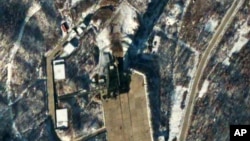North Korea can fire long-range missiles significantly faster, following upgrades to its launch sites, a U.S. expert has observed.
Satellite imagery analyst Nick Hansen told the VOA Korean Service this week that improvements at the Sohae Satellite Launching Station on the Yellow Sea had cut two weeks off a process that used to take 45 days.
Pyongyang does not appear likely to be fire long-range missiles anytime soon. Through images he purchases from satellite companies, the Johns Hopkins University researcher said ongoing construction at the facility would likely make it inoperable for several more months.
But Thursday, South Korea said North Korea test-fired projectiles into the Sea of Japan.
Shortly after the launches, the North called a South Korean live-fire drill near a contested maritime boundary "a grave military provocation."
There is no word on what type of projectile was fired or if the launches were a test of a new weapon.
Earlier this year, North Korea fired multiple rockets, including medium-range missiles, during large scale U.S.-South Korean joint military exercises.
Thursday's launches coincided with widespread speculation that Pyongyang may be preparing to conduct its fourth underground nuclear weapon test, in violation of U.N. resolutions.
U.S. Director of National Intelligence James Clapper said earlier this year North Korea has expanded the size of its Yongbyon uranium enrichment facility and restarted a reactor used for plutonium production.
Clapper said the North's nuclear weapons and missile programs "pose a serious threat" to the United States and Asia, noting Pyongyang is committed to developing a missile that can strike the U.S. mainland.
This story was produced in collaboration with VOA's Korean Services.






